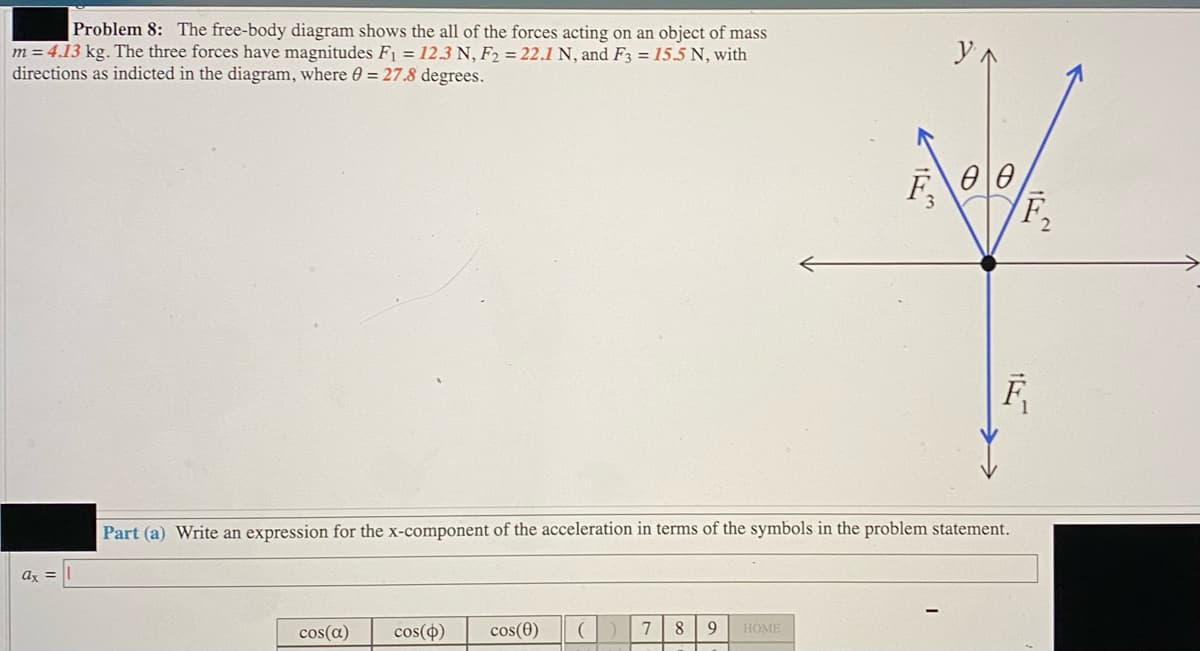Problem 8: The free-body diagram shows the all of the forces acting on an object of mass m = 4.13 kg. The three forces have magnitudes F1 = 12.3 N, F2 = 22.1 N, and F3 = 15.5 N, with directions as indicted in the diagram, where 0 = 27.8 degrees. F2 Part (a) Write an expression for the x-component of the acceleration in terms of the symbols in the problem statement. ax = cos(4) cos(0) 7 8. 9 HOME cos(a)
Problem 8: The free-body diagram shows the all of the forces acting on an object of mass m = 4.13 kg. The three forces have magnitudes F1 = 12.3 N, F2 = 22.1 N, and F3 = 15.5 N, with directions as indicted in the diagram, where 0 = 27.8 degrees. F2 Part (a) Write an expression for the x-component of the acceleration in terms of the symbols in the problem statement. ax = cos(4) cos(0) 7 8. 9 HOME cos(a)
Physics for Scientists and Engineers: Foundations and Connections
1st Edition
ISBN:9781133939146
Author:Katz, Debora M.
Publisher:Katz, Debora M.
Chapter5: Newton's Laws Of Motion
Section: Chapter Questions
Problem 51PQ: Two objects, m1 = 3.00 kg and m2 = 8.50 kg, are attached by a massless cord passing over a...
Related questions
Question
Please solve c

Transcribed Image Text:Part (b) Write an expression for the y-component of the acceleration in terms of the symbols in the problem statement.
Part (c) What is the magnitude of the acceleration, in m/s2?
Part (d) What angle, in degrees, does the acceleration make with respect to the positive x-axis?

Transcribed Image Text:Problem 8: The free-body diagram shows the all of the forces acting on an object of mass
m = 4.13 kg. The three forces have magnitudes F1 = 12.3 N, F2 = 22.1 N, and F3 = 15.5 N, with
directions as indicted in the diagram, where 0 = 27.8 degrees.
F2
Part (a) Write an expression for the x-component of the acceleration in terms of the symbols in the problem statement.
az =
cos(0)
7
8.
9.
HOME
cos(a)
cos(4)
Expert Solution
This question has been solved!
Explore an expertly crafted, step-by-step solution for a thorough understanding of key concepts.
This is a popular solution!
Trending now
This is a popular solution!
Step by step
Solved in 3 steps with 3 images

Knowledge Booster
Learn more about
Need a deep-dive on the concept behind this application? Look no further. Learn more about this topic, physics and related others by exploring similar questions and additional content below.Recommended textbooks for you

Physics for Scientists and Engineers: Foundations…
Physics
ISBN:
9781133939146
Author:
Katz, Debora M.
Publisher:
Cengage Learning

Principles of Physics: A Calculus-Based Text
Physics
ISBN:
9781133104261
Author:
Raymond A. Serway, John W. Jewett
Publisher:
Cengage Learning

Physics for Scientists and Engineers: Foundations…
Physics
ISBN:
9781133939146
Author:
Katz, Debora M.
Publisher:
Cengage Learning

Principles of Physics: A Calculus-Based Text
Physics
ISBN:
9781133104261
Author:
Raymond A. Serway, John W. Jewett
Publisher:
Cengage Learning